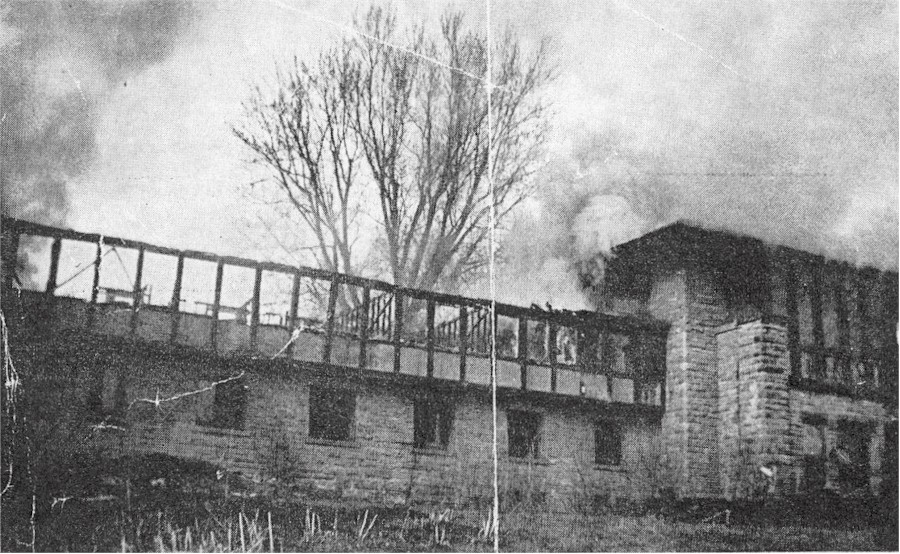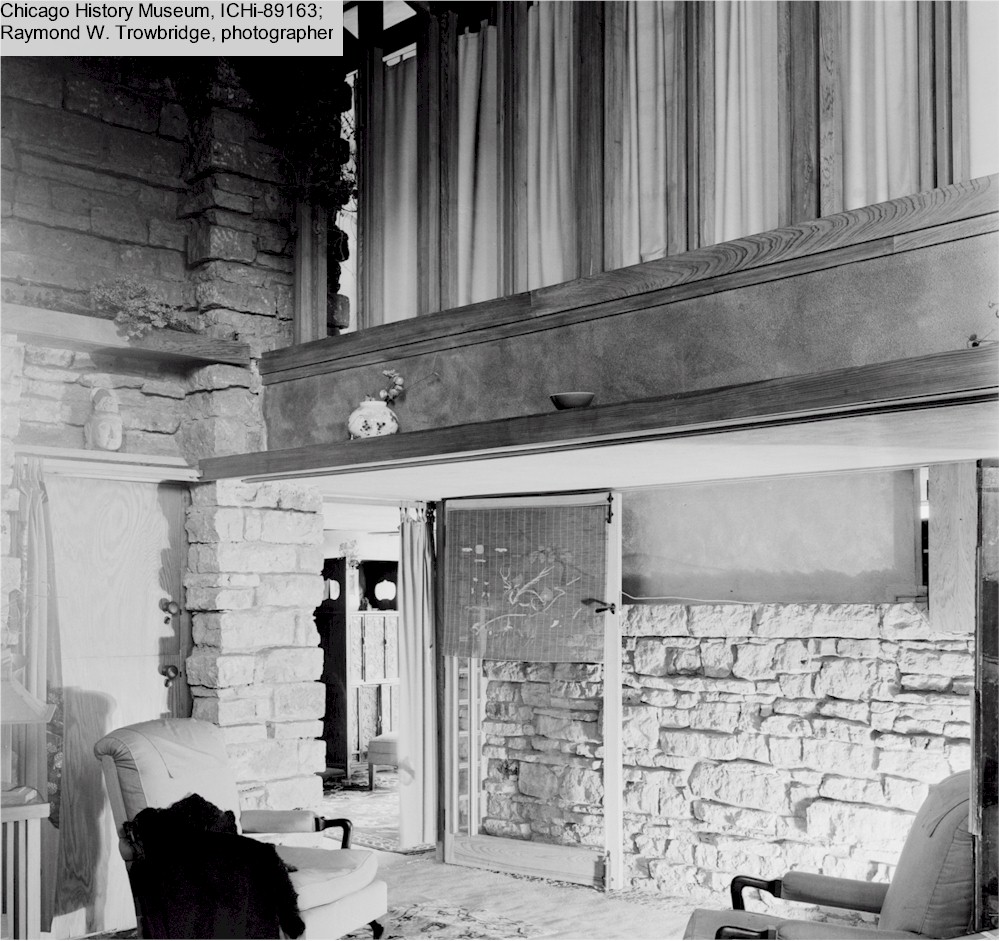Looking northeast at the southern facade of the Hillside building while the smoke still looms in its April 26, 1952 fire. I don’t know who took this photograph. It came from a newspaper article that was given to the Preservation office probably in the 1990s.
As someone who worked at Taliesin, you got used to dealing with questions about fire on the Taliesin estate. Of course, there were the two Taliesin fires,
but that’s not all!
In 1952, a big fire took place at Frank Lloyd Wright’s Hillside building on the south part of the Taliesin estate. That fire happened in April of that year. So, today I’ll talk about the fire and one of Hillside’s rooms affected by it.
I started this after a request:
Someone asked me about the Hillside theater, and its history, a few days ago. As sometimes happens, I know something really well, but don’t know what others don’t know at all. This had great timing, because
the Hillside fire happened nearly 70 years ago
on April 26, 1952.
And I’m trying to push away the knowledge that this means that drummer Stewart Copeland turns 70 this July. Copeland was in the band, The Police (which I adored as a teenager; hence the automatic knowledge on Copeland’s age; he was born on July 16, 1952 btw).
So, follow me while I talk about the original space at Hillside.
The old theater
The Hillside Theater is in the gymnasium Wright designed in 1901 for his Aunts’ Hillside Home School.1 Here’s a photo of the Hillside building when the Aunts ran the school. The gymnasium is on the photo’s far left-hand side:
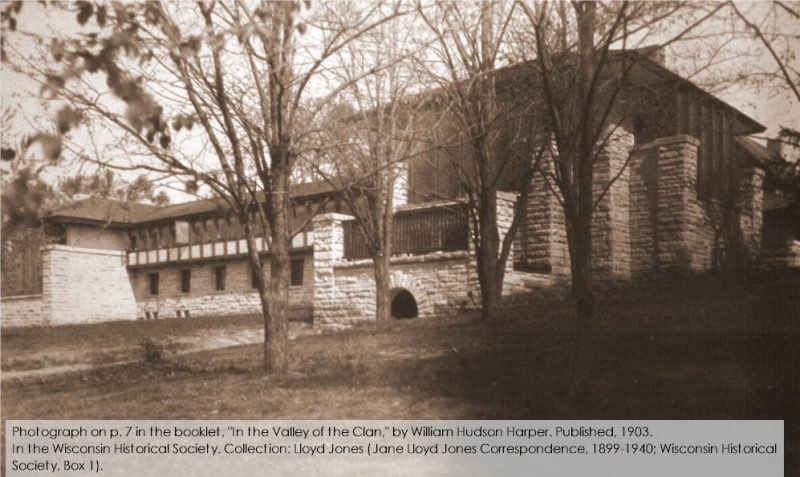
The photo is in the booklet, “In the Valley of the Clan: The Story of a School”.
The booklet is on-line
at the Wisconsin Historical Society. The photo above is on page 7.
The inside of the gym is in the next photo:
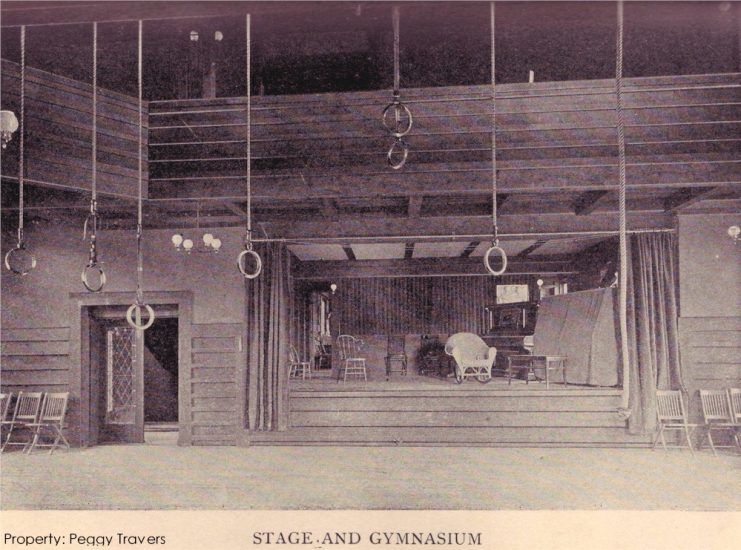
Circa 1903 photo looking east in the Hillside Home School gym and its stage. The gym’s running track was behind the horizontal boards above the stage. Unknown photographer.
Taken from a Hillside booklet owned by Peggy Travers, whose mother went to the Hillside school.
In 1932, when Wright started the Taliesin Fellowship, he redesigned the gym into a theater that he named “the Playhouse”. So, in the first years his apprentices were changing things at his house so they could live there.
(like Edgar Tafel talked about in the book I recommended, Apprentice to Genius).
But they also immediately started renovating the gym into the Playhouse. Like, they took the gym’s running track and rehung it so it was on several different levels.
I don’t know what good that did, but it looked really cool.
Here’s a good drawing of it:
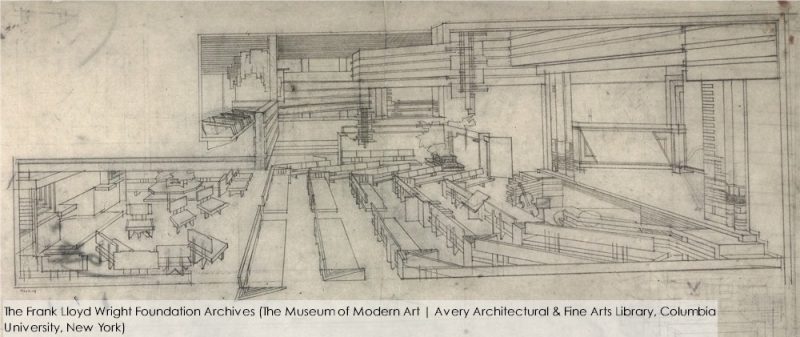
The modified running track is on the upper right. A modified version of this drawing was painted onto plywood. Every Sunday that plywood placard was put alongside the 2-lane highway (Hwy 23) as advertisement for movies at the Playhouse.
You’ll be able to see the placard once the Hillside Theater opens back up after the Frank Lloyd Wright Foundation completes its restoration.
Here’s a video discussion of their current restoration work.
1933 photo of the Playhouse when it was ready to open:
Taken by Angus Vicar. He took the photo the weekend before the Playhouse opened on November 1st, 1933:
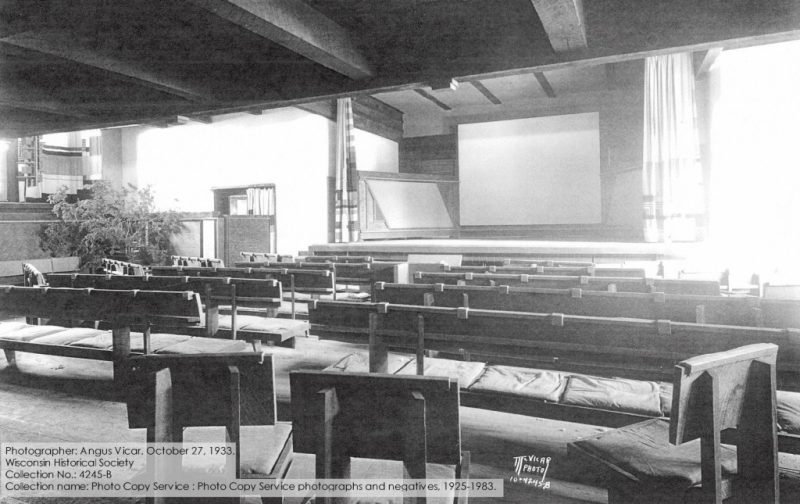
Collection No.: 4245-B.
All this, despite a lack of Mickey Rooney as Andy Hardy saying,
“come on! Let’s put on a show!“
The simple benches you see were constructed by a furniture maker in the Fellowship, Manuel Sandoval. He made them out of newly-cut oak. The “girls” in the Fellowship sewed the seat cushions.
So, movies at the Playhouse were the first public interface by the Taliesin Fellowship. They ran weekly, with apprentices in charge of manning the projector, introducing the movie, preparing coffee or tea for refreshments, and taking money from patrons.
Movies cost 50¢. For a dollar, you could watch the movie as well as get a tour with an apprentice.
This is how hardy we used to be:
That first winter, the Playhouse didn’t have radiator heat. Read this in an “At Taliesin” newspaper article on February 1, 1934:
“The new heating system is in operation, and made the theatre quite comfortable when weather conditions were unfavorable last Sunday.”
No named author. Transcribed from the published article by Randolph C. Henning, but not published in the 1992 “At Taliesin” book edited by Henning.
Eventually, the Wrights and the Fellowship began going to Arizona in the winter (as I noted in this post). Then, as the NEH story states, Wright found the land in Scottsdale in late 1937. The Fellowship then began building Taliesin West as its winter quarters.
In 1952, the Wrights and the Fellowship were returning from their winter when the Hillside fire happened. It destroyed the Playhouse, plus everything to the east up to the Assembly Hall. A stone foyer to the west of the Playhouse (added a few years before) was also untouched.
Below is a transcription of part of a newspaper story about the fire. It comes from the May 1, 1952 edition of Spring Green’s newspaper, the Weekly Home News:
Taliesin School Re-Born on Paper
As Flames Destroy Old Structure
…. Taliesin’s third major fire (the previous two destroyed the house) started late Saturday afternoon [April 26] when a rubbish fire, left unattended, swept toward the building as the wind shifted. A floor containing living quarters above the student dining room was destroyed first; then the flames spread into the theater and reduced it to ashes.
“I lit that rubbish fire myself,” Wright readily admitted.
“It was about 30 ft. from the building and the wind was blowing toward the east. I shouldn’t have gone off and left it, but the wind shifted and carried the fire up under the overhang of the roof. When I came back smoke was coming from the roof and upper floor.”
…. Although a small office adjoining the living room [the Assembly Hall] was badly damaged…, the big room itself suffered only smoke damage. Wright found good in that, too. “That smoke-tone is wonderful,” he said. “I couldn’t have darkened it so evenly if I’d done it myself. Nature is God’s technician.”
Fellowship member “Frances” Nemtin, who joined the Fellowship in early ’46, wrote about it in her booklet, 3 by FLLW. She, then-husband Kenn Lockhart, and their children had been living at the Midway Barns over the winter. On that day in 1952:
… [T]here were a few of us on the grounds…. I was at startled to hear sirens and see fire-trucks and police cars screaming through our valley and turning into Hillside… when I ran onto the nearby roof I saw black smoke rising there. With the children I drove to Hillside fast and found a horrifying scene. The theater was full of flames and the local fire engines were desperately fighting an enormous blaze.
3 by FLLW, by Frances Nemtin (self-published, 2008), 44-45.
As members of the Taliesin Fellowship returned, they cleaned the area, prepping for work. That’s because Wright had already redesigned the space.
The new space, now called the Hillside Theatre/Theater (both spellings are in drawings) pushed out further on the north and south. The apprentices poured concrete and created stadium seating. He designed metal chairs, most of which where put into the concrete.
In 1955, they had a formal evening for Wright’s birthday (June 8) to mark the completion of the work.
Maynard Parker also took photographs at Taliesin that year.
These photographs were published in House Beautiful in November, 1955. One of the photos he took is below:
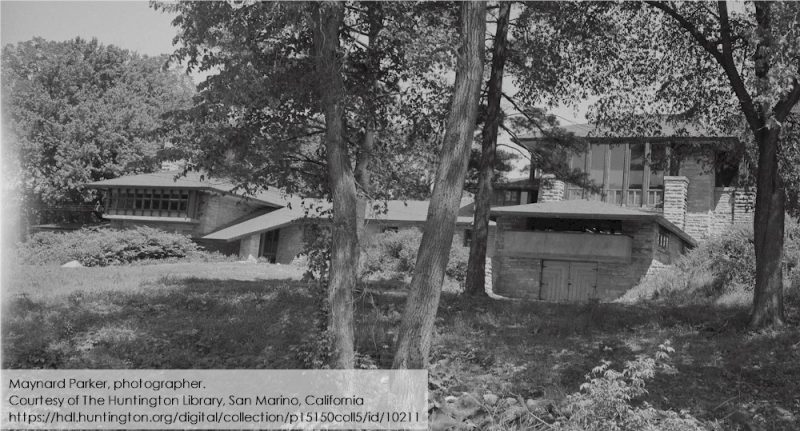
Summer photograph by Maynard Parker looking at the south facade of Hillside. The rebuilt Theater is on the left. An enlarged kitchen at Hillside is on the lower right, under a new roof with a balcony parapet above the stone and wooden doors.
The next year, 1956, the apprentices in the Taliesin Fellowship gave Wright a curtain from his design. Again, here’s Frances Nemtin:
…. It was to be an abstraction of the Wisconsin landscape and executed in felt appliqued on Belgian linen…. Immediately on reaching Wisconsin that April we set out to work in the second floor of Aldebaran, Wes Peters‘ farm, so we could work secretly. We knew if Mr. Wright saw it in progress he’d make constant changes.
3 by FLLW, by Frances Nemtin (self-published, 2008), 49.
Frances and others could not agree on the date of the curtain’s execution. Folks at Taliesin and the Frank Lloyd Wright Foundation didn’t know if it was made in 1954, ’56, or ’57.
Then I got an email:
A woman wrote me at work (as the Taliesin historian). She told me that her parents were in the Taliesin Fellowship and her mother worked on that curtain. And her mother went into labor with her a few days before they finished. And she was born in June of 1956.
So we had our date.
Not cut in stone, but… good enough I’d say.
First published April 15, 2022.
I do not know who took the photograph at the top of this page, but it appeared in a newspaper story on the Hillside fire.
Notes:
1. The building I wrote about in the post, “Another find at Hillside” was the original gymnasium for the Aunts’ Hillside school. That building became the dormitory for older boys once Wright’s building was constructed.

